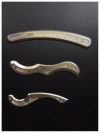Functional Movement Analysis Before and After Instrument-Assisted Soft Tissue Mobilization
- PMID: 30761198
- PMCID: PMC6355138
- DOI: 10.70252/XUJH1351
Functional Movement Analysis Before and After Instrument-Assisted Soft Tissue Mobilization
Abstract
This study examined the effects of instrument-assisted soft tissue mobilization (IASTM) on ankle range of motion in college athletes. Twenty-five Division II college athletes (18-24 yrs) were randomly selected into two groups: experimental group (n = 11) and control group (n = 14). Baseline measurements for both groups included an initial squat assessment, which measured ankle dorsiflexion during the movement, followed by IASTM with ankle rehabilitation exercises, and a secondary squat assessment. During the following week, the experimental group participated in an additional IASTM with rehabilitation session and squat test, while the control group performed a squat test with no treatment. Finally, both groups performed a final squat assessment during the third week after no IASTM treatment. Angle of the ankle during the deepest part of the squat was measured for all four testing sessions for both groups. On average, the ankle angle significantly decreased from the third session to maintenance session. However, post-hoc analyses revealed that a significant decrease in ankle angle was measured from the third session to the maintenance session in the experimental group only. The decrease in ankle angle in the experimental group shows that IASTM increased range of motion by allowing more dorsiflexion during the deepest part of the squat with greatest gains in range of motion found over time during the maintenance period. Thus, IASTM may be used as a performance enhancing tool that has the potential to temporarily increase range of motion and flexibility in college athletes.
Keywords: Fascia; facial adhesion; tissue extensibility; tissue tension.
Figures
References
-
- Armiger P. Preventing musculotendinous injuries: a focus on flexibility. Athl Ther Today. 2000;5(4):20–25.
-
- Baker R, Nasypany A, Seegmiller J, Baker J. Instrument-assisted soft tissue mobilization in treatment for tissue extensibility dysfunction. J Athl Train. 2013;18(5):16–21.
-
- Barnes MF. The basic science of myofascial release: morphologic change in connective tissue. J Bodyw Mov Ther. 1997;1(4):231–238.
-
- Davidson CJ, Ganion LR, Gehlsen GM, Verhoestra B, Roepke JE, Sevier TL. Rat tendon morphologic and functional changes resulting from soft tissue mobilization. Med Sci Sports Exerc. 1997;29(3):313–319. - PubMed
LinkOut - more resources
Full Text Sources





